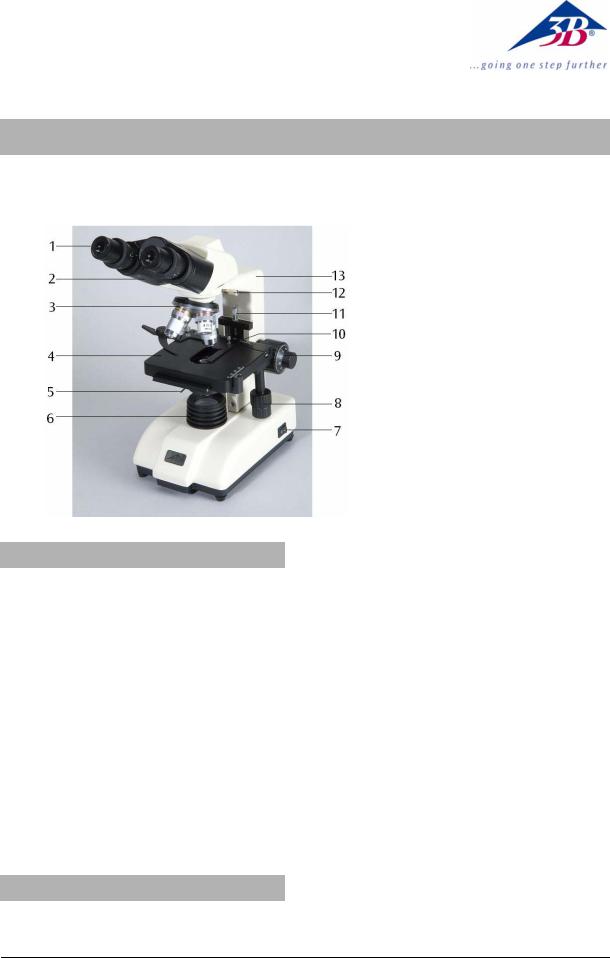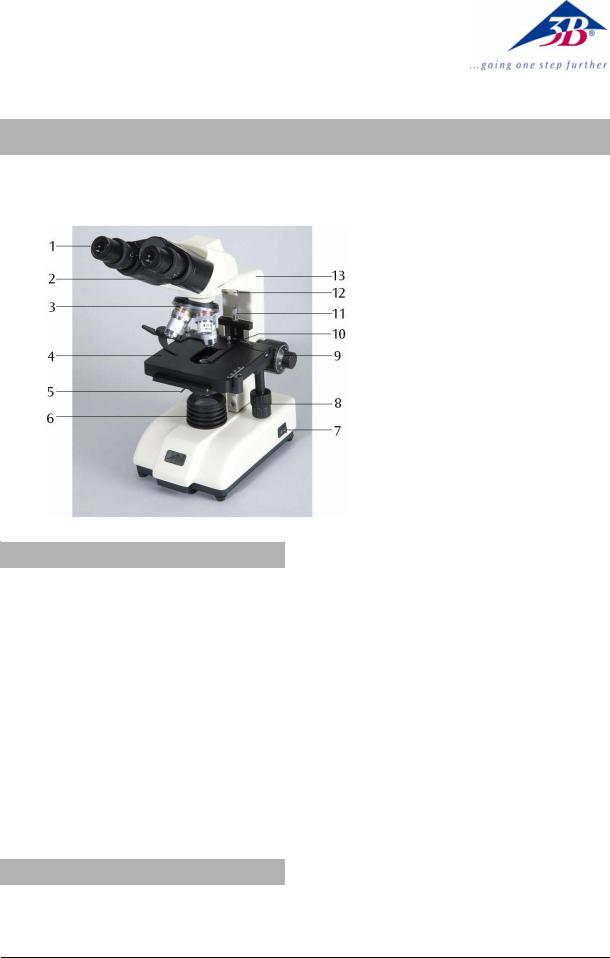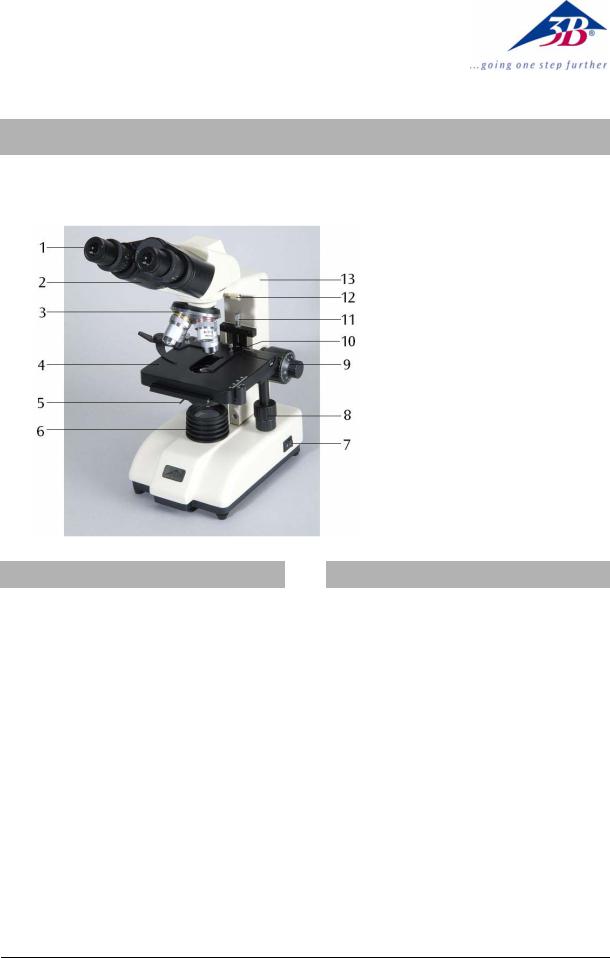3B Scientific 300 User Manual [en, de, es, fr, it]

3B SCIENTIFIC® PHYSICS
Binokulares Kursmikroskop, Modell 300 U30706
Bedienungsanleitung
10/07 ALF
1 |
Okular |
2 |
Tubus |
3 |
Revolver mit Objektiven |
4 |
Objekttisch |
5 |
Kondensor mit Irisblende und |
|
Filterhalter |
6 |
Beleuchtung |
7 |
Netzschalter |
8 |
Koaxialtrieb des Objekttisches |
9 |
Feinund Grobtrieb |
10 |
Objektführer |
11 |
Feststellschraube für Objekt- |
|
tisch |
12 |
Feststellschraube für Mikro- |
|
skopkopf |
13 |
Stativ |
1.Sicherheitshinweise
•Elektrischer Anschluss des Mikroskops darf nur an geerdeten Steckdosen erfolgen.
•Vor Pflegeund Wartungsarbeiten ist immer der Netzstecker zu ziehen.
•Das Mikroskop darf mit keinen Flüssigkeiten in Kontakt kommen.
•Das Mikroskop keinen mechanischen Belastungen aussetzen.
•Optische Teile des Mikroskops nicht mit den Fingern berühren.
•Zur Reinigung des Mikroskops keine aggressiven Reiniger oder Lösungsmittel verwenden.
•Objektive und Okulare zum Reinigen nicht auseinander nehmen.
•Bei Beschädigungen oder Fehlern das Mikroskop nicht selbst reparieren.
2.Beschreibung, technische Daten
Das binokulare Kursmikroskop ermöglicht die zweidimensionale Betrachtung von Objekten (dün-
ne Schnitte von Pflanzenoder Tieren) in 40bis 1000-facher Vergrößerung.
Das Mikroskop U30706-115 ist für eine Netzspannung von 115 V (±10 %) ausgelegt, U30706-230 für 230 V (±10 %).
Stativ: Robustes Ganzmetallstativ, Stativarm fest mit Fuß verbunden; Fokussierung über beidseitig am Stativ angebrachte koaxiale Stellknöpfe für Feinund Grobtrieb, angetrieben über ein Zahnstangengetriebe mit Kugellager; einstellbarer Anschlag zum Schutz der Objektträger und Objektive
Tubus: Binokularer Seidentopf-Kopf, Schrägeinblick 30°, Kopf um 360° drehbar, Augenabstand zwischen 54 mm und 75 mm einstellbar, Dioptrienausgleich ±5 für beide Okulare
Okular: Weitfeld-Okularpaar WF 10x 18 mm
Objektive: Objektivrevolver mit DIN 4 achromatischen Objektiven 4x / 0,10, 10x / 0,25, 40x / 0,65, 100x / 1,25 Öl-Immersion, (mit Präparateschutz)
Vergrößerung: 40x, 100x, 400x, 1000x
Objekttisch: x-y-Kreuztisch, 125 mm x 130 mm, mit Objektführer und koaxialen Stellknöpfen senk-
1

recht zum Objekttisch, Stellbereich 70 x 30 mm2
Beleuchtung: Im Fuß integrierte 5 W Leuchtstofflampe und Sammellinse im Lampenschacht, Netzanschluss 115 V bzw. 230 V, 50/60 Hz
Kondensor: Abbe Kondensor N.A.1,25 mit Irisblende, Filterhalter und Blaufilter, fokussierbar über ein Zahnstangengetriebe
Abmessungen: ca. 282 x 148 x 357 mm³
Masse: ca. 5,2 kg
3. Auspacken und Zusammenbau
Das Mikroskop wird in einem Karton aus Styropor geliefert.
•Nach Entfernen des Klebebands den Behälter vorsichtig öffnen. Dabei darauf achten, dass keine der optischen Teile (Objektive und Okulare) herausfallen.
•Um Kondensation auf den optischen Bestandteilen zu vermeiden, das Mikroskop so lange in der Verpackung belassen, bis es die Raumtemperatur angenommen hat.
•Das Mikroskop mit beiden Händen (eine Hand am Stativarm und eine am Fuß) entnehmen und auf eine ebene Fläche stellen.
•Die Objektive sind separat in Döschen verpackt. Sie werden in der Reihenfolge vom Objektiv mit dem kleinsten bis zum Objektiv mit dem größten Vergrößerungsfaktor im Uhrzeigersinn hinten beginnend in die Öffnungen der Revolverplatte geschraubt.
•Anschließend den binokularen Mikroskopkopf auf das Stativ setzen und mit der Feststellschraube fixieren. Okulare in den Tubus einsetzen.
4.Bedienung
4.1Allgemeine Hinweise
•Das Mikroskop auf einen ebenen Tisch stellen.
•Das zu betrachtende Objekt in die Mitte des Objekttisches platzieren und in der Objektführung festklemmen.
•Netzkabel anschließen und Beleuchtung anschalten.
•Objektträger so in den Strahlengang schieben, dass das Objekt vom Strahlengang deutlich durchstrahlt wird.
•Augenabstand einstellen bis nur ein Lichtkreissichtbar ist.
•Diopterstärke den Augen anpassen.
•Zur Erreichung eines hohen Kontrasts Hintergrundbeleuchtung mittels der Irisblende ein-
stellen.
•Das Objektiv mit der kleinsten Vergrößerung in den Strahlengang drehen. Ein Klick-Ton zeigt die richtige Stellung an.
Hinweis: Es ist am besten mit der kleinsten Vergrößerung zu beginnen, um zuerst größere Strukturdetails zu erkennen. Der Übergang zu einer stärkeren Vergrößerung zur Betrachtung feinerer Details erfolgt durch Drehen des Revolvers bis zum gewünschten Objektiv. Bei Verwendung des Objektivs 100x muss Öl auf den Objektträger gegeben werden.
Die Stärke der Vergrößerung ergibt sich aus dem Produkt des Vergrößerungsfaktors des Okulars und des Objektivs.
•Mit dem Triebknopf für Grobtrieb das unscharf abgebildete Präparat scharf stellen, dabei darauf achten, dass das Objektiv den Objektträger nicht berührt. (Beschädigungsgefahr)
•Anschließend mittels Feintrieb die Bildschärfe nachregeln.
•Zur Benutzung von Farbfiltern Filterhalter ausschwenken und Farbfilter einlegen.
•Mittels des Koaxialtriebs des Kreuztisches lässt sich das zu betrachtende Objekt auf die gewünschte Stelle schieben.
4.2 Sicherungswechsel
•Stromversorgung ausschalten und unbedingt Netzstecker ziehen.
•Sicherungshalter an der Rückseite des Mikroskops mit einem flachen Gegenstand (z.B. Schraubenzieher) herausschrauben.
•Sicherung ersetzen und Halter wieder einschrauben.
5.Aufbewahrung, Reinigung
•Das Mikroskop an einem sauberen, trockenen und staubfreien Platz aufbewahren.
•Bei Nicht-Benutzung das Mikroskop immer mit der Staubschutzhülle abdecken.
•Das Mikroskop keinen Temperaturen unter 0°C und über 40°C sowie keiner relativen Luftfeuchtigkeit über 85% aussetzen.
•Nach Gebrauch sofort die Beleuchtung ausschalten.
•Bei starker Verschmutzung das Mikroskop mit einem weichen Tuch und ein wenig Ethanol reinigen.
•Die optischen Bestandteile mit einem weichen Linsentuch reinigen.
3B Scientific GmbH • Rudorffweg 8 • 21031 Hamburg • Deutschland • www.3bscientific.com Technische Änderungen vorbehalten
© Copyright 2007 3B Scientific GmbH

3B SCIENTIFIC® PHYSICS
Binocular Course Microscope Model 300 U30706
Instruction Manual
10/07 ALF
1 |
Eyepiece |
2 |
Tube |
3 |
Revolver with objectives |
4 |
Object stage |
5 |
Condensor with iris diaphragm |
|
and filter holder |
6 |
Lamp housing |
7 |
Mains switch |
8 |
Adjustment knob for mechani- |
|
cal stage |
9 |
Adjustment knob for fine and |
|
coarse focusing |
10 |
Object guide |
11 |
Lock screw for object stage |
12 |
Head lock screw |
13 |
Stand |
1.Safety notes
•For power supply use only electrical sockets with ground contact.
•Always unplug the mains plug before cleaning or maintenance.
•Be careful not to spill any liquids on the microscope.
•Do not wipe the optics with your hands.
•Do not disassemble objective or eyepieces to attempt to clean them.
•Do not mishandle or impose unnecessary force on the microscope.
•Do not clean the unit with volatile solvents or abrasive cleaners.
•Do not attempt to service the microscope yourself.
2.Description, technical data
The binocular course microscope allows twodimensional viewing of objects (thin sections of plant or animal specimen) in 40x to 1000x magnifi-
cation.
The microscope U30706-115 is for operation with a mains voltage of 115 V (±10%), and the U30706-230 unit is for operation with 230 V (±10%).
Stand: Robust, all metal stand with arm permanently connect to the base. Focussing by means of separate knobs for coarse and fine adjustment located on either side of the stand and operated by rack and pinion drive with ball bearings, adjustable stopper for protecting the object slides and objective
Tube: Binocular Seidentopf head, 30° viewing angle, 360° rotatable head, viewing distance adjustable between 54 and 75 mm, ±5 dioptric compensation for both eyepieces
Eyepiece: Pair of wide field eyepieces WF 10 x 18 mm
Objectives: Revolver with 4 DIN achromatic objectives 4x / 0.10, 10x / 0.25, 40x / 0.65, 100x / 1.25 oil (with specimen protection)
Magnification: 40x, 100x, 400x, 1000x
Object stage: x-y cross table, 125 x 130 mm2, with object guide and coaxial adjustment knobs per-
1

pendicular to the object stage, adjustment range 70 x 30 mm2
Illumination: 5 W incandescent lamp incorporated in the base integrated in base, with a converging lens in lamp shaft, power supply 115 V resp. 230 V 50/60 Hz
Condenser: Abbe condenser N.A.1.25 NA 0.65 with iris diaphragm , filter holder and blue filter, focussed via rack and pinion drive
Dimensions: 220 x 154 x 359 mm³ approx.
Weight: 5.2 kg approx.
3. Unpacking and assembly
The microscope is packed in a molded styrofoam container.
•Take the container out of the carton remove the tape and carefully lift the top half off the container. Be careful not to let the optical i- tems (objectives and eyepieces) drop down.
•To avoid condensation on the optical components, leave the microscope in the original packing to allow it to adjust to room temperature.
•Using both hands (one around the pillar and one around the base), lift the microscope from the container and put it on a stable desk.
•The objectives will be found within individual protective vials. Install the objectives into the microscope nosepiece from the lowest magnification to the highest, in a clockwise direction from the rear.
•Put the binocular head onto the top of the stand and tighten the head-lock-screw. Insert the eyepieces into the tube.
4.Operation
4.1General information
•Set the microscope on a level table.
•Place the object to be observed in the centre of the specimen stage and clamp it to the object guide.
•Connect the mains cable to the net and turn on the switch to get the object illuminated.
•Make certain that the specimen is centered over the opening in the stage.
•Adjust the interpupillary distance so that one circle of light can be seen.
•Make the necessary eyepiece dioptre adjustments to suit your eyes.
•Adjust the aperture of the iris diaphragm to get the background brightness suitable for a high
contrast image.
•Rotate the nosepiece until the objective with the lowest magnification is pointed at the specimen. There is a definite “click” when each objective is lined up properly.
NOTE: It is best to begin with the lowest power objective. This is important to reveal general structural details with the largest field of view first. Than you may increase the magnification as needed to reveal small details. When 100x (oil) objective is chosen, objective oil must be dripped onto the slide.
To determine the magnification at which you are viewing a specimen, multiply the power of the eyepiece by the power of the objective.
•Adjust the coarse-focusing-knob which moves the stage up until the specimen is focused. Be careful that the objective does not make contact with the slide at any time. This may cause damage to the objective and/or crack your slide.
•Adjust the fine-focusing-knob to get the image more sharp and more clear.
•Colour filters may be inserted into the filter holder for definition of specimen parts. Swing the filter holder out and insert colour filters.
•Use the knobs of the mechanical stage to move the slide side-, backand forwards. The vernier provides accurate location of the specimen area.
4.2 Changing the fuse
•Turn off the power switch and unplug the mains plug.
•Unscrew the fuse holder on the back of the stand base with a screwdriver.
•Replace the fuse and reinsert the holder in its socket.
5.Storage and cleaning
•Keep the microscope in a clean, dry and dust free place.
•When not in use always cover the microscope with the dust cover.
•Do not expose it to temperatures below 0°C and above 40°C and a max. relative humidity of over 85%.
•Always turn off the light immediately after use.
•Use a soft linen cloth and some ethanol to clean the microscope.
•Use a soft lens tissue to clean the optics.
3B Scientific GmbH • Rudorffweg 8 • 21031 Hamburg • Germany • www.3bscientific.com Subject to technical amendments
© Copyright 2007 3B Scientific GmbH

3B SCIENTIFIC® PHYSICS
Microscope binoculaire OPTI 2, modèle 300 U30706
Instructions d’utilisation
10/07 ALF
1 |
Oculaire |
2 |
Tube |
3 |
Revolver avec objectifs |
4 |
Platine |
5 |
Condenseur avec diaphragme |
|
à iris et porte-filtre |
6 |
Module de la lampe |
7 |
Interrupteur secteur |
8 |
Réglage coaxial de la table |
|
d’objets |
9 |
Vis macrométrique et micro- |
|
métrique |
10 |
Surplatine |
11 |
Vis de serrage de la platine |
12 |
Vis de fixation de la tête du |
|
microscope |
13 |
Support |
1.Consignes de sécurité
•Ne brancher le microscope qu’à des prises de courant mises à la terre.
•Avant d’effectuer des travaux d’entretien et de maintenance, retirer toujours la fiche secteur.
•Le microscope ne doit jamais entrer en contact avec des liquides.
•Ne jamais exposer le microscope à des contraintes mécaniques.
•Ne pas toucher les parties optiques du microscope avec les doigts.
•Pour le nettoyage du microscope, ne pas utiliser de nettoyants ni de solvants agressifs.
•Pour le nettoyage, ne pas démonter les objectifs ni les oculaires.
•En cas d’endommagement ou de défaut, ne pas réparer soi-même le microscope.
2. Description, caractéristiques techniques
Le microscope binoculaire collège permet d’observer des objets en deux dimensions (coupes fines de plantes ou d’animaux) avec un agrandissement 40 à 1000x.
Le microscope U30706-115 est prévue pour une tension secteur de 115 V (±10 %) et l'alimentation U30706-230 pour une tension secteur de 230 V (±10 %).
Support : Bâti support entièrement métallique. Grande robustesse. Mise au point rapide par pignon/crémaillère à roulement à billes, fine par vis micrométrique à commandes coaxiales de précision. Butée de protection réglable
Tube : Tête de type Seidentopf binoculaire, inclinée à 30°, tête orientable à 360°, écartement interpupillaire réglable entre 54 et 75 mm, réglage dioptrique ±5 pour les deux oculaires
Oculaire : Paire d’oculaires grand champ WF 10x 18 mm
Objectifs : Tourelle revolver avec 4 objectifs achro-
1
